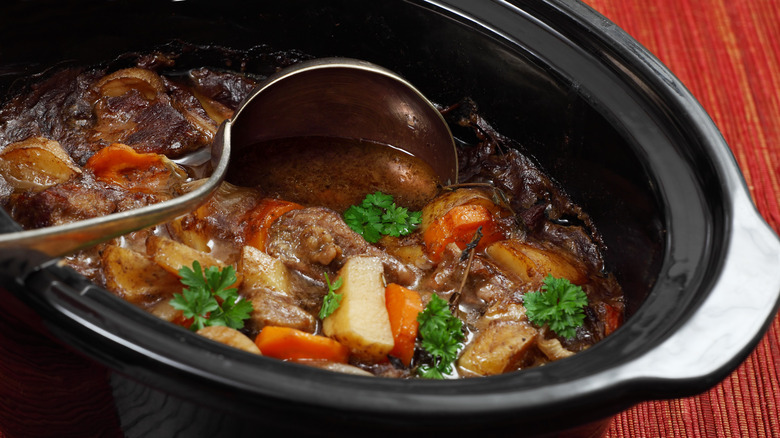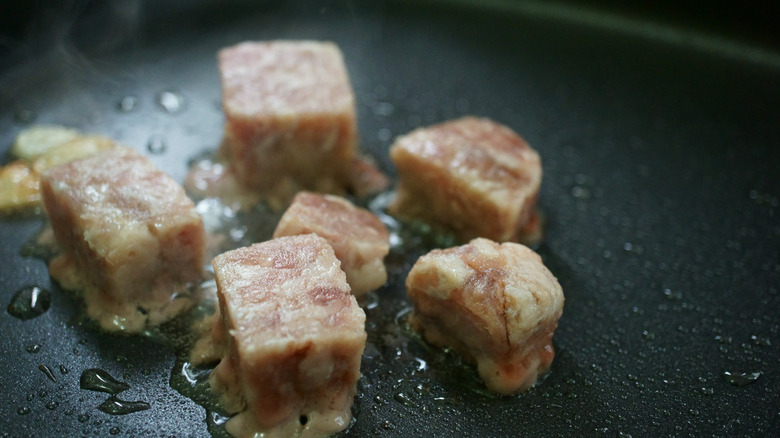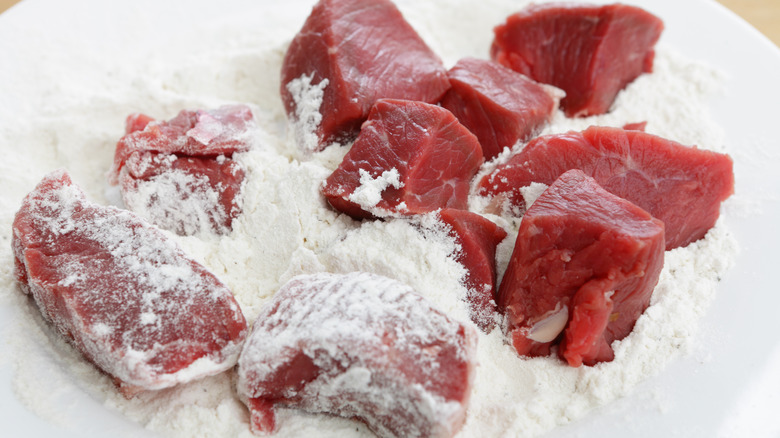The Reason We Always Sear Meat In Flour Before Putting It In The Slow Cooker
We may receive a commission on purchases made from links.
If you've ever tried your hand at homemade beef stew or pot roast in a slow cooker, you've probably noticed that a vast majority of recipes involve coating the meat in flour before searing and simmering. It's a traditional method of slow-cooking any kind of beef stew or bourguignon that most believe to have originated in France, though the when and where is difficult to pinpoint. As for why it's such a prevalent method at all, the two main reasons people will supply are that it helps create a more flavorful sear on the meat and that it thickens up the sauce or broth of the final product.
However, whether these reasons have any factual basis within the science of cooking is a matter of hot debate. While some home chefs insist that the flour adds greater flavor, others point out that scientifically, it would actually impede the processes necessary for proper browning and searing. In the same vein, some claim that flouring the meat makes a smoother broth and prevents any lumping; however, it's worth pointing out that there are other thickening methods that are simpler, more precise, and also avoid the issues that result from adding the flour directly.
How flour interacts with the Maillard Reaction
Despite the longstanding and widespread practice of searing meat in flour before stewing, its supposed benefits fall apart when put under the microscope. First and foremost, the claim that flour helps the meat sear with a better taste is, according to experts, somewhat questionable. The reason that people sear meat before tossing it into a slow cooker in the first place is to get the complex flavor from what's called the Maillard Reaction. Broken down into simple terms, you're caramelizing the surface of the meat with high heat and low moisture to get that deep brown sear with a rich flavor profile that'll seep into the rest of the dish while in the slow cooker.
If you're coating your meat in flour, however, you're essentially browning the flour instead of the meat. There are a few reasons why this might be helpful: the dryness of flour mitigates the natural moisture of the meat, helping the Maillard Reaction happen properly. In addition, flour reacts faster to heat than raw meat, speeding up the browning process. In that sense, flour does help the meat sear "better" — however, food experts point out that browned flour just doesn't taste as good as browned meat. You simply won't be getting much of that intense, rich flavor of properly seared meat in your stew or roast.
Using flour to improve the texture of the dish
The other main reason people sear meat in flour is to preemptively thicken the sauce or broth before cooking. While this can be helpful in thickening the texture without having to make a roux, it's an imprecise method that may not be as effective in dishes with a greater water ratio. If you're making a stew, for example, you may need additional flour later on anyway to achieve that thick, gravy-like consistency. According to The Guardian, most professional chefs prefer to adjust the texture of stews and roasts later in the cooking process by adding a roux, beurre manié, or a quick broth-and-flour slurry in a ladle.
You may also find claims that dredging meat in flour helps retain moisture and improve the texture of the meat itself, but this is a misconception that may have resulted from confusing dredging with velveting. Velveting is a method of tenderizing meat with baking soda or cornstarch commonly found in Chinese cuisine; simple dredging, on the other hand, doesn't involve any marination or tenderizing processes and has minimal effect on the meat texture. With all the facts assembled, it seems that the practice of searing meat in flour before stewing has less to do with real benefits in cooking and more to do with tradition than anything else.


